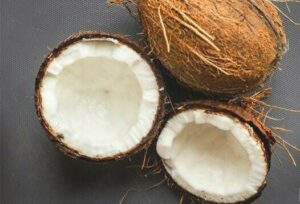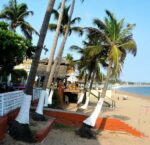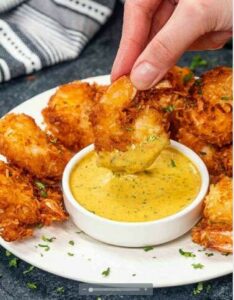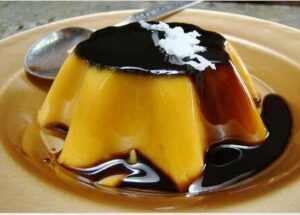 What a long, strange trip it’s been for coconuts, which have spread around the world over the centuries, often on their own. Coconuts travel easily, happily bobbing along in ocean currents from country to country, eventually ending up on a sandy beach or inlet where they take root.
What a long, strange trip it’s been for coconuts, which have spread around the world over the centuries, often on their own. Coconuts travel easily, happily bobbing along in ocean currents from country to country, eventually ending up on a sandy beach or inlet where they take root.
Early explorers, sailors and pirates valued the coconut for its many uses: the water, or “juice;” the meat, the oil and shells — the latter two could be used as fuel. They brought them along on their ships as well, adding to the migration of this valuable foodstuff.
Coconuts are not native to Mexico; biologists have identified two varieties, one originating in India and the other in Southeast Asia. In appearance, they are quite different, with distinct qualities.
The domesticated Pacific coconut is rounder, with a thinner husk and more meat and water. The wild coconut is more elongated in shape — making it easier for them to travel and root — and has a thicker husk, making them more buoyant.
Historians tell us that coconuts arrived on both coasts of Mexico in the mid-1500s, in Acapulco and Colima on the Pacific side, coming from Panama and the Philippines, and on the eastern Atlantic coast through Campeche and Veracruz via the Caribbean islands and West Africa.
Coconut palms grow easily but slowly, taking six to 10 years before they bear fruit. The kind usually cultivated commercially is called a “three-generation tree” because it can support a farmer, his children and grandchildren over a lifespan of 60–80 years.
Despite the name, coconuts aren’t nuts, but are instead classified as stone fruits, or drupes. Drupes have an outer fleshy part that surrounds a pit with a seed inside. With some drupes, we eat the flesh (peaches, cherries, olives, mangos) while with others, we eat the pit (almonds, pecans).

Ever wonder why many palm trees in Mexico have their trunks painted white? I always thought it was to keep the trees cooler and reflect the sun. Wrong! It’s actually calcium hydroxide to repel leaf cutter ants and other pests.
Coconut is so versatile in the kitchen; the meat, oil and water can be used in any number of recipes. And let’s not forget canned coconut cream, which opens up another whole world of deliciousness! Favorite recipes include —
 Coconut Shrimp
Coconut Shrimp
· ½ cup apricot or mango preserves or puréed fresh mango
· 1 Tbsp. Dijon mustard
· 1 tsp. Sriracha or other hot sauce
· 1 tsp. fresh lime juice, plus more as needed
· Pinch of salt
· ½ cup cornstarch
· 1 Tbsp. fresh lime zest
· 1½ tsp. fine sea salt
· 4 large egg whites
· 1 cup shredded unsweetened coconut
· ½ cup panko bread crumbs
· Salt and black pepper
· 1 lb. large raw shrimp (21-25 count), peeled, deveined, with tails attached
· 4-5 Tbsp. coconut or canola oil for frying, plus more as needed
· For dip: combine preserves/mango, mustard, hot sauce, lime juice and salt in small bowl. Thin with lime juice if necessary.
With this combo of coconut, fruit, a zing of lime and the crunch of panko, you’ll find it hard to eat just one of these Coconut Shrimp. (Jo Cooks)
Place cornstarch, zest and sea salt in shallow bowl. Whisk egg whites in another bowl until frothy. Toss coconut and panko in another shallow bowl; season with salt and pepper.
Holding each shrimp by its tail, coat shrimp (but not the tail) in cornstarch mixture; shake off excess. Dip in egg whites; shake off excess. Dredge in coconut-panko mixture, pressing to coat. Set aside. Repeat with remaining shrimp.
In large skillet, pour a thin layer of oil. Heat over medium until oil shimmers and a pinch of the coconut-panko mixture sizzles when added. Add shrimp in a single, even layer (do not crowd the pan); cook until golden brown on bottom, about 2 minutes. Adjust heat as necessary if shrimp browns too quickly.
Using tongs, flip shrimp by grasping tails. Cook until golden brown underneath, 2 minutes more. Remove from pan to plate lined with paper towels. Repeat with all shrimp, adding additional oil as needed. Serve immediately with dip.
 Easy Coconut Flan
Easy Coconut Flan
· 1 (14-oz.) can sweetened condensed milk
· 1⅓ cups whole milk
· 2 eggs + 2 egg yolks
· ½ tsp. vanilla
· ¾ cup unsweetened flaked coconut
Preheat the oven to 350 F (177 C). Bring kettle of water to boil. Arrange six ¾-cup custard cups in a glass or metal baking pan, 13x9x2 inches. In large bowl, combine condensed milk, whole milk, eggs, egg yolks and vanilla. Mix well. Add coconut, stir again. Divide mixture among cups.
Pour boiling water into the baking pan to come halfway up the sides of the cups. Bake about 30 minutes until just set in center, testing by inserting a knife until it comes out clean. Remove flans from pan; set on a rack to cool. Cover and refrigerate until chilled.

Leave a Reply